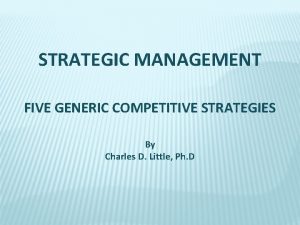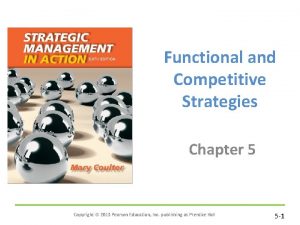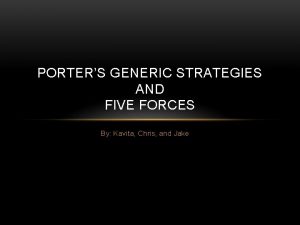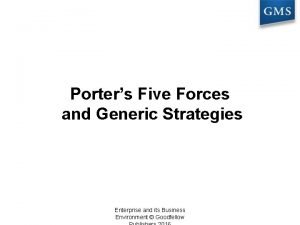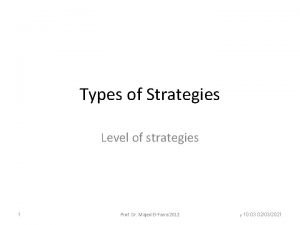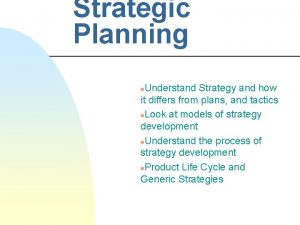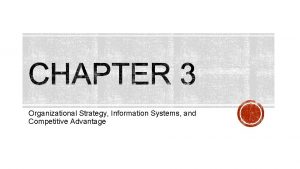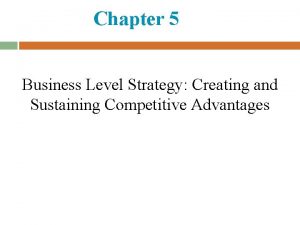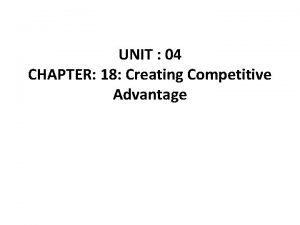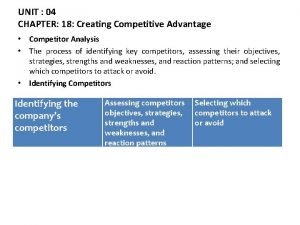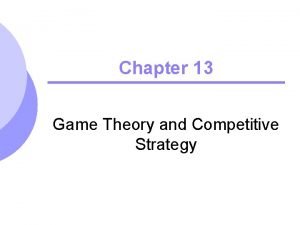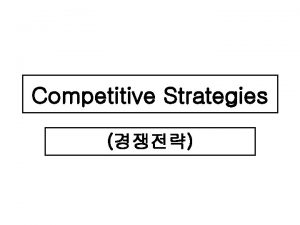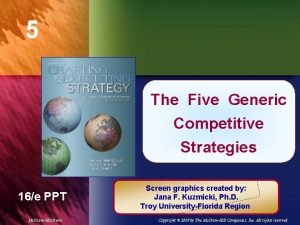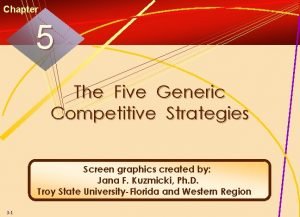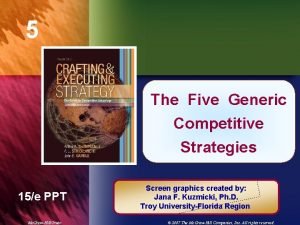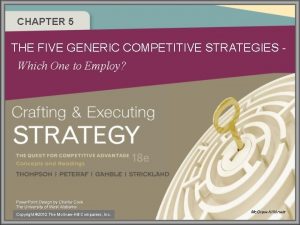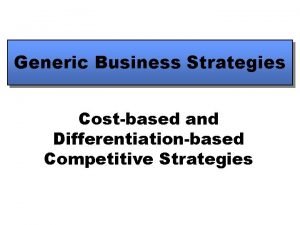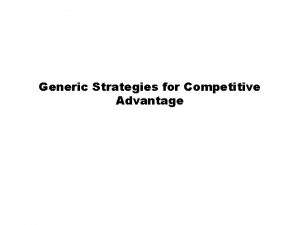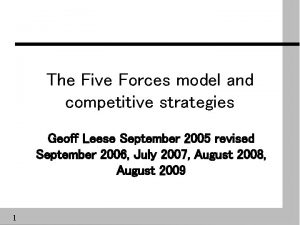Chapter 5 The Five Generic Competitive Strategies Mc



























- Slides: 27

Chapter 5 The Five Generic Competitive Strategies Mc. Graw-Hill/Irwin Copyright © 2011 The Mc. Graw-Hill Companies, All Rights Reserved.

Competitive Strategy § Deals exclusively with management’s game plan for competing successfully and securing a competitive advantage over rivals üSpecific efforts to give customers superior value – A good product at a lower price – A superior product worth paying more for – An attractive mix of price, features, quality, service, and other appealing attributes 5 -2

Competitive Strategies and Industry Positioning 5 -3

Figure 5. 1: The Five Generic Competitive Strategies Type of Advantage Sought Market Target Lower Cost Broad Range of Buyers Narrow Buyer Segment or Niche Mc. Graw-Hill/Irwin Differentiation Overall Low-Cost Broad Provider Differentiation Strategy Stuck in the middle Focused Low-Cost Differentiation Strategy Copyright © 2001 by The Mc. Graw-Hill Companies, Inc. All rights reserved. 4

Perils of “Stuck in the Middle” Strategy § Compromise strategies end up with a middle-of-the-pack industry rankings and provide for average performance ü ü An average cost structure Minimal product differentiation relative to rivals An average image and reputation Limited prospect of industry leadership § Compromise or middle-ground strategies rarely produce sustainable competitive advantage 5 -5

Low Cost Provider Strategies § Powerful competitive approach with price-sensitive buyers ü Have lower costs than rivals—but not necessarily the absolutely lowest possible cost ü Must include features and services that buyers consider essential ü Must not be viewed by consumers as offering little value even if priced lower than competing products. 5 -6

Translating a Low Cost Strategy Into Attractive Profit Performance § Option 1: Use lower-cost edge to under-price competitors and increase market share § Option 2: Maintain present price, be content with present market share, and use lower-cost edge to earn a higher profit margin on each unit sold 5 -7

Approaches to Achieving Low Costs 1. Perform essential value chain activities more costeffectively than rivals 2. Revamp the firm’s overall value chain to eliminate or bypass some costproducing activities altogether 5 -8

When a Low Cost Strategy Works Best § Price competition is vigorous § Product is standardized § There are few ways to achieve differentiation § Buyers incur low switching costs § Buyers are large and have significant bargaining power § Industry newcomers use introductory low prices to attract buyers and build customer base 5 -9

Hazards of a Low-Cost Strategy § Cutting price by an amount greater than size of cost advantage § Low cost methods are easily imitated § Becoming too fixated on reducing costs and ignoring ü Buyer interest in additional features ü Declining buyer sensitivity to price § Technological breakthroughs open up cost reductions for rivals 5 -10

Differentiation Strategies § Powerful competitive approach whenever buyers’ needs and preferences are too diverse to be fully satisfied by a standardized product or service 5 -11

Differentiation Strategies § Incorporate differentiating features that cause buyers to prefer firm’s product or service over brands of rivals § Not spending more to achieve differentiation than the price premium that customers are willing to pay for all the differentiating extras 5 -12

Benefits of Successful Differentiation Successfully executed differentiation strategies allow a company to: § Command a premium price, and/or § Increase unit sales, and/or § Gain buyer loyalty to its brand 5 -13

Types of Differentiation Themes § Unique taste – Dr. Pepper § Multiple features – Microsoft Windows and Office § Wide selection – Amazon. com § Superior service – Ritz-Carlton § Spare parts availability – Caterpillar § Engineering design and performance – BMW § Prestige – Rolex § Product reliability – Johnson & Johnson § Quality manufacture – Toyota § Top-of-line image – Ralph Lauren, Starbucks, Chanel 5 -14

Creating Value for Customers through Differentiation § Incorporate product features/attributes that lower buyer’s overall costs of using product § Incorporate features/attributes that raise the performance a buyer gets out of the product § Incorporate features/attributes that enhance buyer satisfaction in noneconomic or intangible ways § Exploit competencies and competitive capabilities that rivals don’t have or can’t match 5 -15

Where to Find Opportunities to Differentiate § Supply chain activities § Product R&D and product design activities § Production R&D and technology-related activities § Manufacturing activities § Distribution-related activities § Marketing, sales, and customer service activities 5 -16

Perceived Value and Signaling § The price premium commanded by a differentiation strategy reflects actual value delivered and value perceived by the buyer. § Buyers seldom pay value that is not perceived for 5 -17

Perceived Value and Signaling § Important to signal value when: ü Nature of differentiation is subjective ü When buyers are making firsttime purchases ü When repurchase is infrequent ü When buyers are unsophisticated 5 -18

Market Conditions Favoring a Differentiation Strategy § There are many ways to differentiate a product that have value and please customers § Buyer needs and uses are diverse § Few rivals are following a similar differentiation approach § Technological change and product innovation are fast-paced 5 -19

Hazards of a Differentiation Strategy § Buyers see little value in a product’s unique attributes § Appealing product features are easily copied by rivals § Overspending on efforts to differentiate 5 -20

Hazards of a Differentiation Strategy § Overdifferentiating such that product features exceed buyers’ needs § Charging a price premium buyers perceive is too high § Failing to open up meaningful gaps in product or service attributes 5 -21

Focused Low-Cost Strategy § Reflects a concentration on a narrow piece of the total market defined by geographic uniqueness or special product attributes § Avenues to achieving cost advantage are the same as for lowcost leadership—outmanage rivals in keeping costs low and bypassing or reducing nonessential activities 5 -22

Focused Differentiation Strategy § Keyed to offering carefully designed products or services to appeal to the unique preferences and needs of a narrow, well-defined group of buyers 5 -23

Market Conditions Making a Focused Strategy Viable § The target niche is big enough to be profitable and offers good growth potential § Industry leaders have chosen not to compete in the niche § It is costly or difficult for multisegment competitors to meet the specialized needs of niche buyers § Industry has many niches and segments § Few rivals are attempting to specialize in the niche 5 -24

Hazards of a Focused Strategy § Competitors find effective ways to match a focuser’s capabilities in serving niche § Niche buyers’ preferences shift towards product attributes desired by majority of buyers § Segment becomes so attractive it becomes crowded with rivals, causing segment profits to be splintered 5 -25

Successful Strategies Must Be Well. Matched to Resources and Capabilities § Low-Cost Providers ü Must have the resources and capabilities to keep its costs below those of its competitors ü Must have expertise to cost-effectively manage value chain activities better than rivals § Differentiators ü Must have the resources and capabilities to incorporate unique attributes that a broad range of buyers will find appealing and worth paying for 5 -26

Successful Strategies Must Be Well. Matched to Resources and Capabilities § Narrow Segment Focusers ü Must have the capability to do an outstanding job of satisfying the needs and expectations of niche buyers 5 -27
 Five generic competitive strategies with examples
Five generic competitive strategies with examples Five generic competitive strategies examples
Five generic competitive strategies examples Porter's competitive strategies
Porter's competitive strategies Mintzberg generic competitive strategies
Mintzberg generic competitive strategies Porters five generic strategies
Porters five generic strategies Porters 3 generic strategies
Porters 3 generic strategies Chapter 5 competitive rivalry and competitive dynamics
Chapter 5 competitive rivalry and competitive dynamics Four building blocks of competitive advantage
Four building blocks of competitive advantage Least competitive market
Least competitive market Therapeutic index
Therapeutic index Types of generic strategies
Types of generic strategies Generic strategies examples
Generic strategies examples Porter's value chain model
Porter's value chain model What are porter's four competitive strategies?
What are porter's four competitive strategies? Focused strategy
Focused strategy Generic functions of public administration
Generic functions of public administration Growing and internationalizing the entrepreneurial firm
Growing and internationalizing the entrepreneurial firm 5 business level strategies
5 business level strategies Five strategies
Five strategies Multidomestic orientation
Multidomestic orientation These beauteous forms
These beauteous forms Five of five
Five of five 5 senses and 5 elements
5 senses and 5 elements Drum and colors macbeth
Drum and colors macbeth Value creation strategy
Value creation strategy Competitor centered company
Competitor centered company Chapter 13 game theory and competitive strategy
Chapter 13 game theory and competitive strategy Chapter 2 strategic planning for competitive advantage
Chapter 2 strategic planning for competitive advantage

